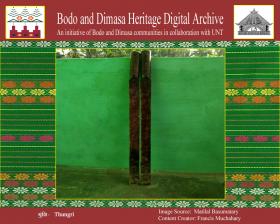खेराइसालि (Kheraisali)
Kherai puja is the biggest religious celebration of the Bodo. They perform Kherai puja jointly once or twice a year as a sign of hope and desire that has persisted among them since the beginning of time for the welfare of their existence. Besides the welfare of both personnel and the general population, the Kherai puja is performed for the successful harvest of crops. The Bodos are generally dependent on agriculture. So, before and after cultivation, they perform Kherai puja and propitiate different gods and goddesses for success in cultivation. Kherai puja is quite extravagant and intricate as well.
It is difficult to ascertain the source from which the word ‘Kherai’ was derived. Different scholars and writers have different opinions as regards the origin of the word. According to S.K. Chatterjee, there is a similarity between the ‘Ker Puja’ of the Tripuris and the ‘Kherai Puja’ of the Bodos. The Bathou Bwrai chief of the gods of the Bodo is also known as Kherai Bwrai or Khuria Bwrai which means ‘the latent old man’. He is believed to be endowed with all qualities. The Bodo call him ‘Kharia’ the latent entity with all qualities. Therefore, some believe as the Kherai puja is performed in his name, the Kharia Bwrai, the word Kherai has its origin in the word Kharia Bwrai, Khubrai=Khurai=Kherai.
There is another explanation for the origin of the term ‘Kherai’. The sacrifice of birds and animals is essential for the Kherai puja. The sound ‘Khe’ is produced when a goat or pig is sacrificed before the Bathou by cutting the neck of the sacrificed animal with a particular ‘dao’ at a stroke. The worshippers of the Bathou use to believe that the Kherai word originates from the sound ‘Khe’ and it is added with the word ‘rai’ which means chanting formula before the chief god Bathou (Kherai Bwrai). Therefore, it is also believed that the word ‘Kherai’ is derived from a combination of Khe + rai= Kherai.
The Bodos have no temple or a fixed shrine of worship. They select any suitable place when they have to worship their gods and goddesses. An altar is prepared by the intending worshippers. The altar is long and divided into three parts, starting from the south and ending in the north. Generally, the grazing field is selected for making an altar for the Kherai Puja. In the first part of the altar, a piece of cloth is hung up above the ground. It indicates the formless (Nirakar) existence of the Obonlaoree (the God). In the middle part, the Bathou is symbolised by a planted ‘Sijou tree’ (Euphorbia splendens). The Sijou tree is surrounded by a round fence of small bamboo strips folded with five fastenings symbolising the religious and spiritual principles grouped in five. Under the Sijou tree, a sacred earthen lamp (alari bati) is lighted. Five shares of areca nuts and betel leaves, unripe bananas and other sacred things are put on the plaintain leaflets placed under the Sijou tree. A pot filled with pure water is also installed there and the top branches of jatrasi or tulsi (basil) plants are kept in the pot for sprinkling the holy water from within the pot on the altar. As a symbol of creation and truth, an egg and a stone are kept in front of the Bathou respectively. From the middle part of the altar to the northern sections some rows of khangkla (a kind of sacred plant) are planted leading to the northern end, where Mainao the goddess of wealth or crops is installed. The northern part of the altar symbolises the beautiful and prosperous ‘Mother Earth. Two holy persons, a Dauri and Daudini remain as the holy custodian of puja under the guidance of the Oja (a medicine man) who perform all the religious rites. The surroundings of the entire altar are kept pure by burning aromatic incense sticks, dhuna and sandan. The Kherai puja continues for three days and nights, unlike earlier days which lasted for seven days and nights.
[ Source: A Study in Cultural Heritage of the Boros- By Dr. Kameswar Brahma]




Add new comment